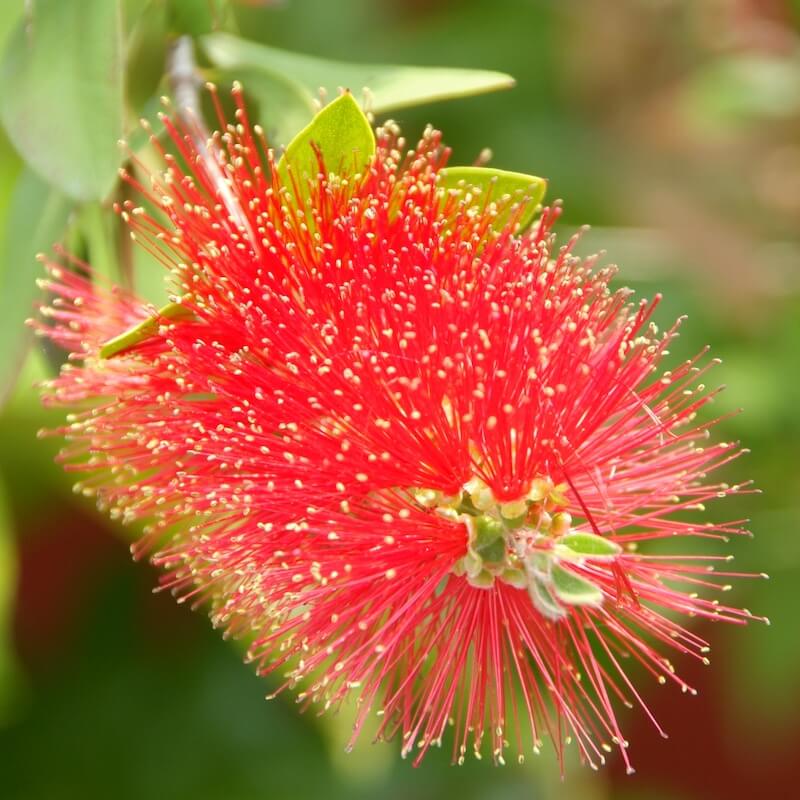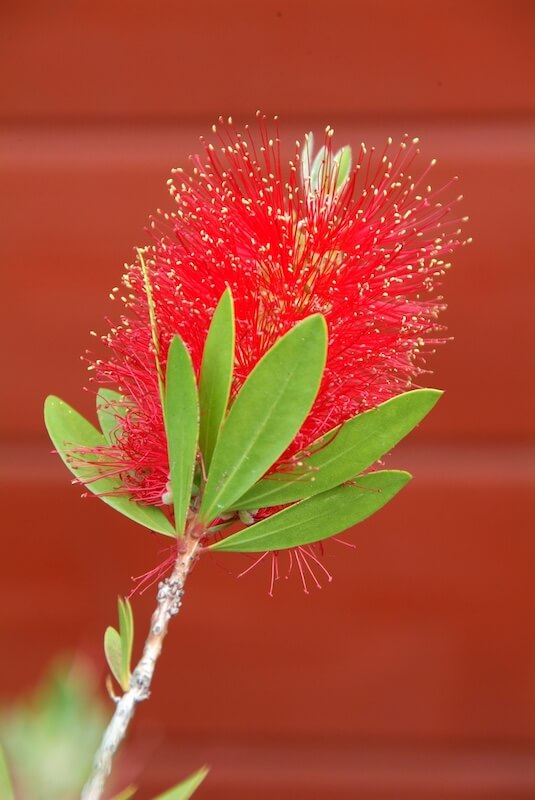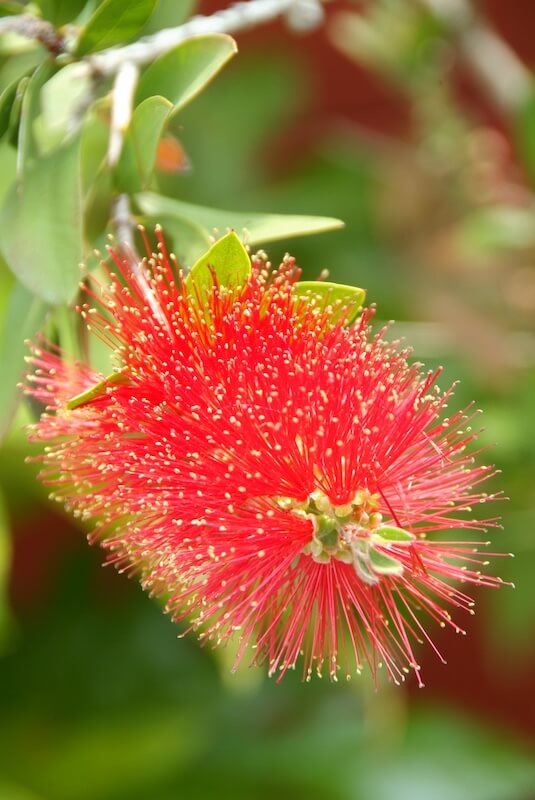
Position
- Full sun is essential for abundant flowering and strong leaf colour
- Sheltered from cold easterly or northerly winds—against a south- or west-facing wall is ideal
- Tolerates coastal exposure where winters are mild
Hardiness
- Survives down to about –5 °C (23 °F) in a sheltered microclimate
- In colder sites, protect the root zone with a thick mulch and consider temporary fleece on young growth
Soil
- Prefers light, free-draining soils: sandy loam or chalky mixes perform best
- Incorporate plenty of sharp sand or fine gravel at planting for improvement of drainage
- Avoid heavy clay or waterlogged ground
- Suited to acid, neutral or mildly alkaline soils
- Performs best where organic matter maintains good structure and moisture retention
- Grab a soil test kit and ensure the perfect conditions for growth
Height
- Reaches approximately 3–4 m (10–13 ft) tall under favourable conditions
Seasons of Interest
Additional Notes
- Prune lightly immediately after the main flush of flowers to encourage a second bloom and keep the shape neat
- Mulch annually in spring with well-rotted compost to conserve moisture and improve soil structure
- Water regularly during establishment; once settled, it is tolerant of short dry spells but avoids prolonged drought
- Protect young plants from severe frosts with horticultural fleece or situate them in a conservatory/greenhouse in the coldest regions
- Attractive to bees and nectar-seeking insects—an excellent pollinator plant
- Can be grown in large containers if full sun and good drainage are assured; requires winter protection in pots
Crimson Bottlebrush Plant – Add an Exotic Touch to Your Borders
Callistemon citrinus, often called the crimson bottlebrush, is one of the most eye-catching shrubs you can grow in UK gardens. Famous for its bright red flowers that resemble a bottle brush, it brings instant drama to borders, patios, and courtyard spaces. This attractive evergreen shrub delivers year-round interest with aromatic foliage, striking cylindrical flower heads, and a naturally bushy habit.
What Makes Callistemon citrinus Such a Garden Favourite?
Callistemon citrinus is an evergreen shrub and a native of Australia, loved for its distinctive cylindrical flower heads that appear in late spring and summer. These bright red flowers are fluffy red spikes that draw the eye instantly, making the plant a superb focal point. Its aromatic foliage adds another layer of appeal, especially when brushed on a warm day.
This bottlebrush plant is adaptable, hardy in milder parts of the UK, and can be grown in borders or large pots. It offers year-round interest, with dense green lance-shaped leaves providing structure even outside flowering time. A sheltered position helps it to produce the best bloom, and well-drained soil is key to keeping it healthy.
How Does the Crimson Bottlebrush Flower?
The crimson bottlebrush produces vibrant flower spikes that look like a red bottlebrush. These cylindrical flower heads are made of hundreds of tiny blooms, creating a fluffy texture that’s impossible to ignore.
Flowering peaks in late spring and summer, though in sheltered gardens, you might see a second flush in autumn. The bloom period delivers a burst of colour when many other shrubs are settling into summer green, making it an excellent companion for salvias and lavenders.
What Does the Foliage Add to the Display?
The evergreen plant has aromatic foliage that stays attractive all year. The lance-shaped leaves are a fresh mid-green, providing a perfect backdrop to the bright red flowers.
New growth often has a soft, slightly silvery sheen before maturing, adding to the plant’s ornamental appeal. The foliage is also helpful in garden design, as its fine texture contrasts beautifully with larger-leaved shrubs and perennials.
Where Should You Plant a Bottlebrush for Best Results?
For the best flowering performance, grow your bottlebrush in full sun in a sheltered position, away from cold drying winds. In cooler parts of the UK, a sunny courtyard or south-facing wall will give the warmth and shelter it needs.

How and When to Prune a Crimson Bottlebrush
To keep your crimson bottlebrush in good shape, prune immediately after flowering. This encourages fresh growth and more blooms the following year.
Remove any dead or damaged wood and lightly trim the tips of arching branches to maintain a bushy shape. Avoid hard pruning into old wood, as this can reduce flowering.
Is Callistemon citrinus Hardy in the UK?
Callistemon citrinus is a hardy plant in milder areas, especially in coastal or urban gardens. In colder regions, it may need winter protection, such as fleece or a sheltered planting spot.
Avoid planting where the soil becomes waterlogged in winter. Potted plants can be moved to a frost-free location during freezing weather to protect roots from freezing.
How to Combine Bottlebrush with Other Plants
Bottlebrush looks stunning alongside drought-tolerant plants such as salvias and lavenders. Their complementary colours and textures make for an eye-catching display.
Use it as a feature shrub in a mixed border, or in a container near a seating area where you can appreciate its aromatic foliage and fluffy red flowers up close.
Long-Term Care for Your Bottlebrush Plant
Once established, Callistemon citrinus is drought-tolerant, making it low-maintenance. Water regularly in the first year, then only during prolonged dry spells. Feed annually in spring with a general fertiliser.
Watch for woody seed capsules forming after flowering – these add winter interest but can be removed if you prefer a tidier look. With the proper care, this attractive evergreen shrub will give many years of colour and structure.
From Darren’s Patch
There’s something undeniably uplifting about seeing a Callistemon citrinus in full bloom – those vivid red bottlebrush flowers almost seem to hum with energy. In my garden, I’ve found it’s a plant that never fails to turn heads, whether it’s brightening up a sunny border or adding drama in a large container by the patio. The aromatic foliage is a joy too – brush past it on a warm day and you get a gentle, citrusy fragrance that instantly feels summery. With a bit of shelter, good drainage, and a light trim after flowering, it’s an easy-going shrub that rewards you year after year. For me, it’s the perfect blend of bold beauty and low maintenance – and that’s a rare combination worth cherishing.
![]()
Key Points to Remember
- Type: Attractive evergreen shrub with aromatic foliage
- Flowers: Bright red flowers in cylindrical heads in late spring and summer
- Position: Full sun in a sheltered position
- Soil: Well-drained soil enriched with compost
- Pruning: Prune immediately after flowering to maintain shape
- Hardiness: Hardy plant in milder areas; protect in colder regions
- Uses: Borders, containers, focal points in UK gardens
- Care: Drought-tolerant once established; mulch annually
Callistemon citrinus rewards a sunny, sheltered UK garden with year-round evergreen structure and a long season of brilliant red blooms. With minimal pruning, a spring mulch and reliable drainage, it makes a stunning, low-maintenance feature even in coastal or mild-winter areas.
Want to learn about other shrub varieties? Read about Aucuba japonica Rozannie here.
For more information on Shrubs for your garden, please click here.

Frequently Asked Questions
Q: What is Callistemon citrinus, and why is it called the bottlebrush plant?
A: Callistemon citrinus, often called the bottlebrush plant or crimson bottlebrush, is an attractive evergreen shrub native to Australia. It earns its common name from its striking cylindrical flower spikes, which resemble a traditional bottle brush. In late spring and summer, this hardy plant produces bright red flowers in fluffy red cylindrical flower heads that are a magnet for pollinators. The aromatic foliage is lance-shaped, adding year-round interest even when the shrub is not in bloom. Ideal for UK gardens, it thrives in well-drained soil and a sunny, sheltered position, rewarding you with vibrant colour and distinctive structure.
Q: How do I plant a crimson bottlebrush in my garden?
A: When planting Callistemon citrinus, choose a spot with full sun and shelter from cold winds. This evergreen plant prefers well-drained soil enriched with compost to encourage healthy root growth. For potted plants such as Callistemon citrinus 2 litre specimens, water well before planting and ensure the hole is twice as wide as the root ball. Backfill with a compost mix and firm gently. Add a mulch layer around the base to retain moisture while avoiding the stem. For young plants, provide winter protection in colder regions to safeguard against frost damage and promote a strong start.
Q: How should I care for a bottlebrush shrub after planting?
A: Caring for a bottlebrush shrub involves regular watering during the first year until established plants can tolerate drier conditions—this drought-tolerant plant benefits from a light feed in spring to encourage vigorous growth and prolific bloom. Prune immediately after flowering to maintain a bushy shape and promote more flower spikes for the following year. Remove any dead or damaged stems. Apply compost and mulch annually to nourish the roots and conserve moisture. Avoid waterlogged or frozen soil conditions, as these can damage the roots, especially in perishable plants, if extreme winter cold is expected.
Q: When does Callistemon citrinus flower, and how can I prolong its display?
A: Callistemon citrinus typically flowers in late spring and summer, producing bright red flowers in distinctive cylindrical flowerheads along its arching branches. To prolong the display, prune lightly immediately after flowering to encourage new growth and additional bloom later in the season. Feeding with a balanced compost mix in spring helps sustain healthy foliage and vibrant flower spikes. A sheltered position in full sun enhances flowering, while avoiding waterlogged soil keeps roots healthy. By following these care steps, your crimson bottlebrush will remain an eye-catching feature in your garden for many years.
Q: Is Callistemon citrinus suitable for UK gardens?
A: Yes, Callistemon citrinus is well-suited to UK gardens if given the right conditions. As an evergreen shrub with aromatic foliage and striking red bottlebrush flowers, it brings year-round interest and structure. While considered a hardy plant in mild areas, young plants may need winter protection in colder climates. Established plants tolerate drought well, making them ideal companions for other drought-tolerant plants such as salvias and lavenders. Plant in well-drained soil with good sun exposure and shelter from strong winds to enjoy its distinctive bloom and foliage for decades.
